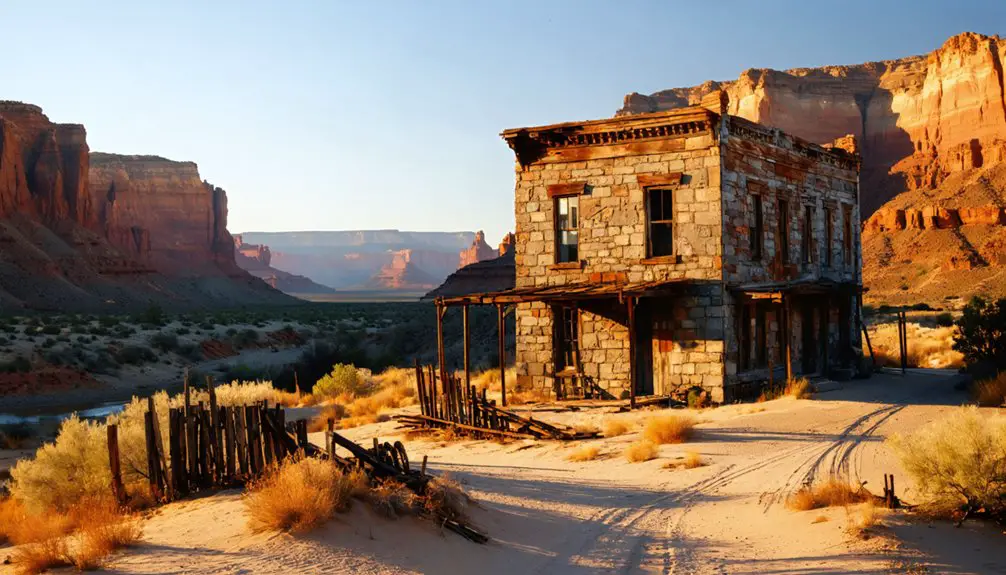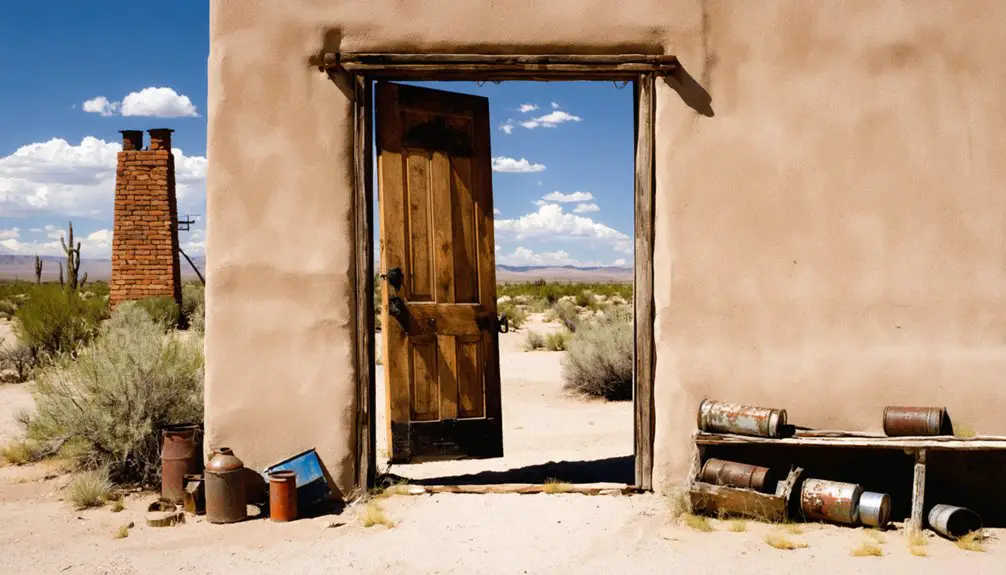You’ll find Westwater’s haunting ruins along the Colorado River near the Utah-Colorado border, where a once-thriving frontier settlement peaked at 2,500 residents in the 1870s. The town flourished during Utah’s mining boom as prospectors sought gold and silver, while the Denver and Rio Grande Western Railroad’s arrival in 1883 transformed it into a crucial rail hub. Today, abandoned grounds and archaeological sites tell tales of frontier justice, Chinese railroad workers, and countless prospectors who shaped this wild outpost.
Key Takeaways
- Westwater was a thriving frontier settlement near the Utah-Colorado border that attracted miners, cattlemen, and outlaws in the 1800s.
- The mining community in Ruby Canyon peaked at 2,500 residents during the 1870s before declining as mining opportunities diminished.
- Limited farmland, scarce water resources, and the end of railroad construction contributed to Westwater’s eventual abandonment.
- The Denver and Rio Grande Western Railroad’s completion in 1883 briefly sustained Westwater before economic shifts led to its decline.
- Archaeological discoveries in 1979 revealed Anasazi ruins, while today the area primarily serves recreational purposes for whitewater rafting.
The Rise of a Colorado River Settlement
As you explore Westwater’s history, you’ll discover how this remote outpost emerged as an essential point along the Colorado River near the Utah-Colorado border.
The settlement’s strategic location attracted a diverse mix of pioneers, from cattlemen to outlaws, who carved out their existence in the rugged canyon terrain. The area became increasingly populated during the mid to late 1800s as prospectors arrived seeking their fortunes in gold and silver. Today, the community consists of 21 scattered homes across 120 acres of desert scrubland.
The challenging rapids and isolated geography shaped Westwater’s unique frontier character.
Life in Ruby Canyon’s Mining Frontier
As you explore Ruby Canyon’s mining frontier of the 1870s, you’ll find a bustling community where boarding houses and post offices served the nearly 2,500 residents at its peak.
You’d see miners adapting to seasonal work patterns, moving between claims during warmer months while contending with isolation and limited transportation options for hauling ore. Like other mining towns of the era, they relied on steam-powered pumps to manage water influx in the shafts. The miners faced similar challenges to those in silver-lead districts, where early knowledge of valuable deposits was documented as far back as 1857.
The arrival of organized community structures brought a mix of frontier justice and economic stability, though the settlement’s fortunes remained tightly bound to the success of local mining operations and the precious metals market.
Mining Community Daily Life
Life in Westwater’s mining community centered around the demanding realities of frontier existence near Ruby Canyon. You’d find yourself living in simple wooden cabins or tents, fetching water from the river or wells, and adapting to harsh seasonal changes.
Community gatherings at saloons and general stores provided essential social connections, while mining accidents were treated with basic medical care right at the worksite. Picture Gallery settlements were nearby, offering additional trading opportunities.
Your daily routine would involve long shifts underground, wielding hand tools in poorly ventilated tunnels while facing the constant threat of cave-ins. Like many mining communities of the era, Westwater saw an influx of Irish and Welsh immigrants seeking work in the mines.
When you weren’t working, you’d join neighbors at communal cooking areas, sharing meals and stories. The tight-knit workforce relied on mutual aid for survival, and you’d spend evenings playing cards or attending occasional dances, finding brief respite from the grueling work that defined frontier life.
Railroad’s Economic Impact
When the railroad networks expanded across Utah’s mining frontier in the late 1800s, you’d witness a dramatic transformation of Ruby Canyon‘s economic landscape. The arrival of railroad infrastructure revealed unprecedented opportunities for mineral transportation, connecting isolated mines to national and international markets.
Here’s how the railroads revolutionized Ruby Canyon’s mining operations:
- You could ship ore directly to distant smelters in Baltimore, San Francisco, and even Wales.
- Your mining costs dropped greatly due to efficient rail transport.
- You’d see new investment flowing into previously undeveloped areas.
The Denver and Rio Grande Western Railroad’s completion to Salt Lake City in 1883 was particularly transformative, as it acquired strategic lines that secured essential mining traffic routes through Ruby Canyon, making your mining operations more profitable and sustainable. The railroad’s narrow-gauge line initially served the region before being converted to standard gauge during the 1889 reorganization. Local contractors played vital roles in building the track infrastructure throughout Utah’s rugged terrain.
Frontier Justice and Order
Three stark realities defined frontier justice in Ruby Canyon’s mining camps: minimal law enforcement, frequent vigilante action, and swift retribution.
You’d find yourself in a world where disputes over mining claims often turned deadly, and the nearest sheriff might be days away. Without formal courts, miners took justice into their own hands through vigilante groups that didn’t hesitate to hang, shoot, or banish troublemakers.
In Westwater’s early days, you’d see law enforcement emerge through informal networks centered around saloons and trading posts. Local mining companies hired armed guards, while community leaders formed posses to maintain order. The Denver & Rio Grande Railway eventually brought more structured authority to the region. The lawless environment mirrored that of other mining areas, where whiskey and gambling dominated the social scene until more civilized settlements emerged.
As families arrived and permanent settlements grew, they demanded more structured justice systems. But until railroads brought government presence and formal institutions, frontier justice remained a brutal necessity in Ruby Canyon’s untamed wilderness.
Railroad’s Influence on Westwater’s Growth
You’ll find Westwater’s origins closely tied to the Denver & Rio Grande Western Railroad’s expansion through Utah Territory, which brought infrastructure and employment opportunities to this remote area.
The railroad’s presence transformed Westwater into a significant rail hub, where crews maintained equipment and coordinated coal shipments from nearby mining operations.
As trains connected Westwater to larger markets in both the east and west, the settlement flourished with new businesses and services catering to railroad workers and travelers.
Railroad Construction Spurs Settlement
The construction of the Denver & Rio Grande Western Railroad brought dramatic changes to Westwater in the late 19th century, transforming it from empty desert into a bustling frontier outpost.
As railroad expansion pushed through Utah’s challenging terrain, Westwater emerged as a critical supply and labor hub, where you’d find:
- Supply trains delivering rails, ties, and construction materials to support advancing track crews
- Mormon workers from nearby communities providing essential labor and construction expertise
- Settlement patterns forming around the endpoint of tracks, where construction camps evolved into more permanent communities
The town’s strategic location along the rail line made it an ideal logistics center, with local economies thriving from the constant flow of workers needing food, lodging, and supplies.
You’ll find that Westwater’s growth directly mirrored the settlement dynamics common to railroad boom towns of that era.
Rail Hub Economic Impact
As Westwater evolved from a construction hub into an established rail center, its economic influence rippled across Utah’s industrial landscape.
You’ll find that rail transport transformed this once-isolated location into an essential link for Utah’s booming mining and agricultural sectors, though today it stands as a ghost town economy frozen in time.
The rail hub’s significance extended beyond just moving freight – it created thousands of jobs in maintenance, security, and operations.
You could see the impact in the surge of mining output, with specialized infrastructure handling massive daily ore shipments.
Local businesses thrived as the railroad brought supplies, workers, and new opportunities.
The railway’s presence attracted diverse workers and tradespeople, temporarily turning Westwater into a bustling center of commerce before its eventual decline.
Notable Characters and Local Legends

While many Utah ghost towns boast tales of miners and prospectors, Westwater’s historical tapestry weaves together a diverse cast of characters who shaped its unique identity.
You’ll find outlaw legends of bootleggers running illicit goods along river routes, and mysterious disappearances in abandoned corners of town.
Modern river stories continue to build Westwater’s legacy, with thousands of adventurers traversing the Colorado River’s challenging waters.
Here’s what makes Westwater’s characters uniquely compelling:
- Government explorers and early settlers who established ranching operations
- Notorious outlaws who used the remote location as their hideout
- Contemporary river runners who’ve transformed the ghost town into a celebrated outdoor destination
Mike Milligan, a river guide turned historian, has preserved these tales through his detailed documentation of Westwater’s colorful past.
From Boom Town to Abandonment
Located near the western terminus of Ruby Canyon along the Colorado River, Westwater emerged as a bustling frontier settlement during the late 19th century.
Nestled at Ruby Canyon’s end, Westwater rose from the frontier landscape as a thriving Colorado River settlement.
You’ll find its economic shifts followed a familiar pattern – mining and railroad construction initially drove prosperity, with grazing and ranching playing supporting roles.
The community dynamics shifted dramatically as mining opportunities dwindled and railroad construction ceased.
Without its primary economic engines, Westwater couldn’t sustain itself. Limited farmland, scarce water resources, and a lack of modern utilities accelerated the town’s decline.
Young residents sought opportunities elsewhere, leaving behind a shrinking population that couldn’t maintain local businesses or services.
Today, Westwater stands as a reflection of the boom-and-bust cycle that defined many Western frontier settlements, its abandoned grounds now primarily used for grazing.
Archaeological Remains and Historic Sites

Through extensive archaeological excavations in 1979, researchers uncovered significant Anasazi ruins and artifacts at the Big Westwater site, revealing a rich prehistoric heritage that predates the ghost town’s mining era.
You’ll find evidence of long-term occupation, including ceremonial kivas and pottery fragments, that tell the story of Native American life until around A.D. 1250.
Historic preservation efforts have focused on protecting these invaluable remains through:
- Collaborative stabilization projects between local agencies and stakeholders
- Careful documentation and cleaning of archaeological artifacts
- Balanced management of tourism and cultural resource protection
The Mike Milligan papers at the University of Utah offer detailed insights into Westwater’s later period, while archaeological studies of nearby ghost towns have revealed diverse ethnic histories, particularly of Chinese railroad workers and other marginalized communities.
River Recreation and Modern Tourism
As one of Utah’s premier whitewater destinations, Westwater Canyon draws approximately 10,000 rafting enthusiasts annually to its challenging 17-mile stretch of the Colorado River.
You’ll encounter 11 named rapids ranging from class I to IV, with conditions varying dramatically based on seasonal water flows between 1,000 and 16,000 cubic feet per second.
If you’re planning river activities, you’ll want to launch from the Westwater Campground ranger station near I-70’s exit 227.
Beyond rafting, you can explore the adjacent Wilderness Study Area or tackle the legendary 140-mile Kokopelli Trail.
Adventure beyond the rapids by discovering pristine wilderness areas and conquering the epic Kokopelli Trail’s rugged terrain.
For outdoor adventures, spring offers ideal rafting conditions with flows between 3,000 and 8,000 cfs.
Westwater’s Place in Grand County History

Deep in Utah’s Grand County, Westwater emerged as an essential frontier settlement in the late 19th century, serving miners, railroad workers, and ranchers who sought their fortunes in the American West.
The town’s community connections extended throughout the region, establishing significant cultural heritage links with neighboring settlements like Castleton and Plainsfield.
You’ll find Westwater’s historical significance reflected in three key aspects:
- Population of over 100 residents in the 1890s, making it a major mining town
- Strategic role as a supply hub for local villages and ranching operations
- Rich social fabric that attracted explorers, dreamers, and outlaws alike
While Westwater now stands abandoned, its legacy lives on as a reflection of the pioneering spirit that shaped Grand County’s early development.
Frequently Asked Questions
Are There Any Documented Deaths or Accidents at the Westwater Mining Sites?
While studying this ghost town’s history, you’ll find no specifically documented mining accidents at Westwater sites, though nearby Utah mines experienced numerous fatal rockfalls and gas explosions during that era.
What Native American Tribes Originally Inhabited the Westwater Area?
You’ll find the Utes were the primary Native Tribes in this area, particularly the Uintah band, who historically lived near the Colorado River. The Western Ute bands maintained significant presence here.
How Accessible Is Westwater Ghost Town During Winter Months?
Through snow and ice, through mud and mire, you’ll need four-wheel drive to reach this site. Winter travel is challenging, and ghost town accessibility depends heavily on unpredictable road conditions.
Were There Any Schools or Churches Established in Westwater?
You won’t find any documented schools or churches in historical records. Unlike other Utah ghost towns that have clear school history and church significance, there’s no evidence of these institutions ever existing there.
What Specific Minerals or Resources Were Mined Around Westwater?
Like veins of life beneath desert stone, you’d find uranium deposits in the Morrison Formation, placer gold along the Colorado River, and dimension stone quarries marking this ghost town’s mining legacy.
References
- https://www.youtube.com/watch?v=AoiIha-3iNo
- https://jacobbarlow.com/2016/05/03/westwater-utah/
- https://onlineutah.us/westwaterhistory.shtml
- http://www.expeditionutah.com/forum/index.php?threads/ghost-town-westwater-grand-county-utah.4617/
- https://www.grandcountyutah.net/388/Ghost-Towns-Communities
- https://en.wikipedia.org/wiki/Colorado_River
- https://coloradosun.com/2025/03/23/westwater-utah-navajo-nation-community-running-water/
- https://npshistory.com/publications/glca/uhq-v28n3-1960.pdf
- https://digitalcommons.usu.edu/usupress_pubs/145/
- https://missoulacurrent.com/colorado-river-conversation/



